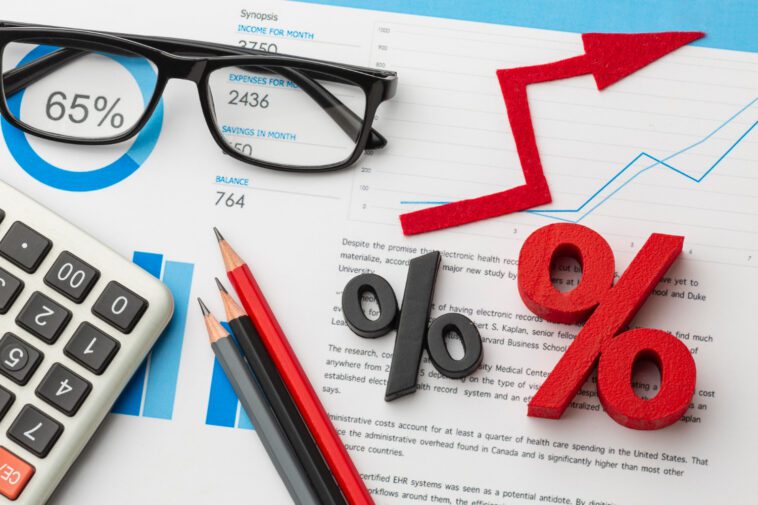Interest rates are one of the key elements that influence how people borrow and spend money. They have a significant impact on borrowers, lenders and investors alike; understanding how they function can help you make informed financial decisions.
For example, low interest rates are more appealing to borrowers than high ones because they save them on interest payments over the life of a loan. The exact rate you pay depends on several factors like inflation and credit availability/demand in an economy.
What is an interest rate?
An interest rate is the fee a bank or lender charges borrowers to borrow money. It’s a percentage of the total amount loaned (the principal), which must then be repaid over time. This charge is reported annually and can apply to loans as well as savings accounts or certificates of deposit at banks or credit unions.
Interest rate is a crucial element of economic activity. A high interest rate can encourage consumers and investors to save and invest more, while a low one will lead to an increase in inflation.
Interest rates on loans are determined by several factors, such as the riskiness of the borrower, what the bank pays to get the funds it lends, and how much overhead is allocated to managing that portfolio. Furthermore, loan servicing costs–the expense of administering and protecting against default–come into play as well.
Some loans feature fixed interest rates that remain consistent over a set period of time. Others feature variable interest rates that fluctuate based on an index; these can be found on student loans and credit cards where monthly payments may change according to how the index changes.
Interest rates are an integral component of the financial system, yet their workings may be opaque to those unfamiliar. They’re also susceptible to unpredictable market forces and other external influences like global pandemics that cannot be controlled.
Therefore, it is essential for people to have a basic understanding of interest rates and how they affect them. With this understanding, individuals can make more informed decisions regarding their finances and be better equipped in case interest rates suddenly increase.
An interest rate is an effective tool of economic policy, capable of stimulating the economy when inflation is low or slowing inflation when it’s high. It may also encourage consumption spending and investment in riskier assets like stocks and bonds.
How is an interest rate determined?
An interest rate is the amount that lenders charge on top of the principal on a loan. It’s typically expressed annually and often referred to as an “annual percentage rate” or APR.
An interest rate can also be applied to the money a bank or credit union earns from savings accounts and certificate of deposit (CD) accounts. They will calculate their rate based on how much they borrow from borrowers and what they earn from depositors.
Banks typically pay interest on their funds to obtain them, then add in loan servicing costs and overhead to determine how much profit they make from loans. Furthermore, they must factor in the risk that borrowers will default on payments.
No matter whether a loan is secured by property or not, banks will calculate their interest rate based on several factors such as the creditworthiness of the borrower and the overall economic environment. Ultimately, this interest rate should maximize profits for the bank while still being affordable to the borrower.
The interest rate has an enormous effect on the economy, as it drives up prices of goods and services. When inflation is high, it becomes harder for people to purchase what they need; this may discourage consumption spending and lead to slower economic growth overall.
Conversely, low interest rates can help combat inflation and spur investment activity. Furthermore, it allows borrowers to make more money from their investments.
In the United States, the Federal Reserve System sets interest rates. They do this mainly by lending directly to banks and purchasing and selling U.S. Treasury securities, setting monetary policy and setting rules for banks when setting their own interest rates.
Why is an interest rate determined?
An interest rate is determined by several factors, including the state of the economy, government policies and market forces. Ideally, rates should be set so they make lenders money but still attract borrowers.
Interest rates are a crucial factor for savers when it comes to earning returns on their savings. By depositing money into a bank, they’ll receive an interest-bearing percentage as compensation for keeping it there. On the other hand, if they choose to loan some of their money out, lenders also pay them a portion in exchange for using it to lend other people money.
As a borrower, your interest rate will be determined by the bank or financial institution that you borrow from. They take into account your credit history and income to find you the most advantageous loan possible.
They will also consider your time frame, tax implications and other important financial details. If a lender believes you pose more of a risk than someone with excellent credit and an ample down payment, they may increase your interest rate to cover any extra risk they assume.
The federal funds rate, which is the interest rate at which banks borrow and lend overnight between themselves, is the primary factor in determining an interest rate. Other elements that could impact it include inflation and currency value in a country.
Interest rates are an integral element in the economy, as so many financial assets depend on them. By understanding the broader context of interest rates, you can make better investments and minimize losses over time.
Interest plays a pivotal role in market economies by controlling money supply and demand – thus its influence over prices. It also plays an important role in coordinating savings and lending decisions; when savers have more cash, loanable funds become scarcer, leading interest rates to decline; conversely, when more people want to borrow than current savings can provide, new money must be priced more expensively.
What is the effect of an interest rate on the economy?
Interest rates have a profound effect on the economy. They affect consumers, businesses and government finances alike – whether for better or for worse depending on the circumstances.
Interest rate increases typically make borrowing more costly and cause consumers to delay spending. This is an effective tool used by central banks to curb inflation.
Similarly, lower interest rates make borrowing more affordable and encourage people to save, which in turn stimulates economic growth. This explains why governments tend to reduce interest rates during times of economic downturn.
However, lower interest rates can have detrimental effects on the economy. For instance, if rates rise, it makes it harder for Americans to purchase homes or cars, leading to reduced consumer demand and hurting businesses’ bottom lines.
Interest rates also influence a country’s currency value. When an official interest rate rises in that nation, its currency’s value typically increases due to increased investment from foreign savers.
An economy’s growth can be significantly affected when there has been a prolonged recession.
Interest rates have a profound impact on the economy, not only because they influence bank savings accounts and fixed income investments such as bonds, but they are an integral factor in financial markets and portfolio performance. They influence virtually every aspect of investing, from bond valuation to stock market returns.
A central bank is an independent organization that manages monetary policy, including interest rates and the money supply. They set these rates and use them to stimulate or slow the economy according to their mandates – maximising employment opportunities while keeping prices stable.
In the United States, for instance, the Federal Reserve is in charge of setting the interest rate that banks charge one another. Their goal is twofold: maximum employment and stable prices.
The Federal Reserve’s decisions to raise or lower interest rates can have a major effect on the economy. When they raise rates, borrowing becomes more costly for both consumers and businesses alike, leading to reduced spending and job creation. Conversely, when they reduce rates, this encourages borrowing which in turn encourages spending and job growth.



